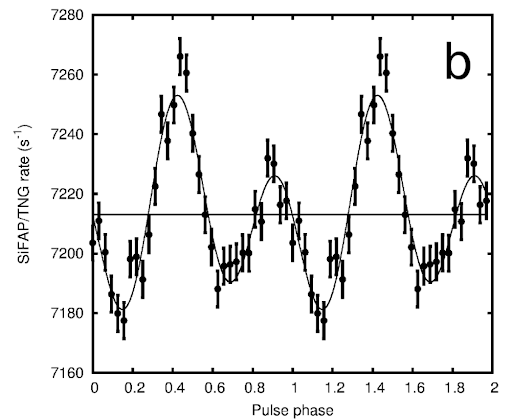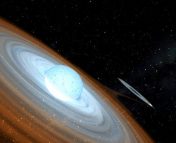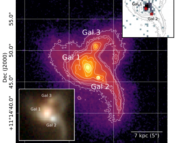Title: Investigating the origin of optical and X-ray pulsations of the transitional millisecond pulsar PSR J1023+0038
Authors: G. Illiano, A.Papitto, F. Ambrosino, A. Miraval Zanon, et al. (20 additional authors)
First Author’s Institution: INAF-Osservatorio Astronomico di Roma (Astronomical Observatory of Rome; National Institute for Astrophysics)
Status: Accepted for publication in Astronomy & Astrophysics [closed access]
Pull out your stopwatches– today’s article pulls a whole lot of physics out of a time delay only 0.0002 seconds long! The radio astronomy community takes lots of interest in millisecond pulsars (MSPs), rapidly spinning neutron stars which emit radio waves from their poles. Pulsars are formed when a massive star undergoes a supernova explosion, leaving behind an extremely dense neutron star which spins slower as it ages. MSPs are the fastest-rotating pulsars, with the fastest pulsar rotating over 700 times a second!
We believe that MSPs form from a pulsar in a binary orbit with a main sequence star like our Sun, a typical star which hasn’t collapsed yet – our Sun is light enough that it won’t form a pulsar, but rather a less dense white dwarf. The gravitational attraction of the heavy pulsar pulls the outer layers of stellar material from the star towards the pulsar. An accretion disk will form and rotate around the MSP, eventually falling onto the surface of – and transferring its angular momentum to – the pulsar, making it spin much faster. We’ve observed binary systems undergoing accretion, as well as MSPs in binary systems, but we’ve never directly seen a system transition between these two stages until the discovery of the pulsar J1023+0038 (J1023 for short), the subject of today’s paper.
J1023 was detected using optical telescopes, and was identified as a binary system with accretion onto a neutron star actively taking place. However, in 2007, radio observations of J1023 found a new periodic signal from a millisecond pulsar, and optical follow-up confirmed that the optical signatures of active accretion were gone. At some point, J1023 had transitioned from an accreting state into a standard, rotation-powered MSP, making it the first confirmed transitional MSP!
In 2013, J1023 unexpectedly switched back to an accreting state; the optical, X-ray, and gamma-ray emission got much brighter while the periodic radio emission became undetectable. J1023 has stayed in this state from 2013 until the time of writing (December 2022). These studies indicate that the transition from an accreting binary to MSP isn’t smooth; the system can wobble back and forth between states before it settles into becoming a full-time MSP.
Clocking Every Pulse

Previous studies have found that in this accreting state, there are detectable optical pulses, or periodic bursts of brighter optical emission at the exact spin period of the neutron star. Figure 1 shows the pulse profile of the optical pulses, or the strength of the optical emission as a function of the rotational phase of the pulsar. We have also detected X-ray pulses from J1023 in its accreting state, and they randomly appear and disappear on the timescales of minutes, suggesting that whatever emission mechanism creates the X-rays is very turbulent. Follow-up studies have shown that the optical and X-ray pulses appear and disappear almost perfectly in sync, so their emission mechanisms are likely very closely-related, but beyond that, no one really knows what those mechanisms could be!
Today’s authors aimed to get simultaneous observations at optical and X-ray wavelengths to learn more about how J1023 produces those types of emission. The previous observations used to study this system hinted at a time lag between the X-ray and optical pulses only fractions of a millisecond long, but the instruments lacked the timing precision to make a definitive finding. Today’s study oversaw the gradual transition to using the much more precise NICER X-ray observatory on the International Space Station and Aqueye+ photometer on the Copernicus telescope in Asiago, Italy – NICER has a timing error of a few nanoseconds, and Aqueye+ has a timing error of less than a nanosecond!

The authors measured the time delay between the X-ray and optical pulses using both the old and new observatories, and found consistent delays roughly 100-200 microseconds long – a confirmation that the time delay is real. Figure 2 shows the measured delays between X-ray and optical pulses using different observatories on different dates. Over time (moving from the bottom to the top of the figure), the average time delay between the pulses doesn’t change dramatically, but the usage of more precise observatories allows for better measurements of the time lag. After lots of these observations, the authors found that there’s no single value that consistently models the delay between the pulses, but they tend to fall around 200 microseconds.
So, how can this measurement of the time lag help us understand the enigmatic nature of J1023? We know that the optical and X-ray pulse profiles are very similar, and that when the X-ray pulses turn off or turn back on, the optical pulses do the same almost immediately. The authors put forward the theory that despite the presence of the accretion disk around the pulsar, the pulsar is still rotating deep within this cloud of gas. We would not be able to see the periodic radio emission from this rotating pulsar, because the accretion disk around it blocks the radio emission from escaping. Rotating pulsars create pulsar winds, outflows of very energetic particles, which could still affect its environment even if the disk blocks us from seeing it.
The pulsar wind could clash into the inner edge of the accretion disk, creating a shock that would emit both X-rays and optical pulses, explaining the similarities between the two. Synchrotron emission, the type of emission that would be created by a shock like this, takes different amounts of time to be emitted depending on the frequency of the light being created, which could explain why the X-ray and optical pulses display a time lag. J1023 is clearly a very complicated and exciting system, and the clock is ticking until we make more discoveries; every microsecond counts!
Astrobite edited by Catherine Clark
Featured image credit: MPG / Mark Garlick / SPL – Agentur Focus; Ansgar Koreng




